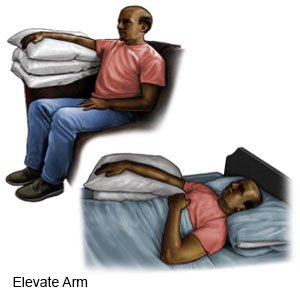Soft Tissue Foreign Body
Medically reviewed by Drugs.com. Last updated on Apr 6, 2025.
What is a soft tissue foreign body?
A soft tissue foreign body is an object that is stuck under your skin. Examples of foreign bodies include wood splinters, thorns, slivers of metal or glass, and gravel.
What are the signs and symptoms of a soft tissue foreign body?
- A hard lump under your skin
- An open wound
- Pain when you touch the injured area
- Redness and swelling
- Bruising or bleeding
How is a soft tissue foreign body diagnosed and treated?
Your healthcare provider may press on the edges of your wound to feel for the foreign body. You may need an x-ray, ultrasound, or CT scan to help find the foreign body. You may be given contrast liquid to help the foreign body show up better in the pictures. Tell the provider if you have ever had an allergic reaction to contrast liquid.
- A foreign body may dissolve or come out of your skin without treatment. It may take weeks or months for this to happen. Your provider will decide if the foreign body should be removed. The foreign body may not be removed if it could harm your blood vessels or nerves. You may need medicine to decrease pain and prevent infection such as tetanus. Tell your provider if you have had the tetanus vaccine or a tetanus booster within the last 5 years.
- Your provider may make a small incision and use tools to remove the foreign body. Your provider may flush your wound to prevent infection. You may need surgery if the foreign body cannot be found or removed through a small incision.
How do I care for the wound?
Care for the wound as directed to help prevent problems such as an infection. The following are general guidelines:
- Apply firm, steady pressure for 5 to 10 minutes if your wound bleeds. Use a clean gauze or towel to apply pressure.
- Keep your wound clean and dry. Your healthcare provider may tell you to leave the bandage in place for the first 48 hours. You may be told to change the bandage sooner if it gets wet or dirty. Then change the bandage as often as directed, and if it gets wet or dirty. If your wound is packed, remove and change the packing as directed. Cover the area with a bandage as directed.
- When your provider says it is okay to bathe, carefully wash around the wound with soap and water. Let soap and water run over your wound. Do not scrub your wound. Dry the area and put on new, clean bandages as directed.
How can I manage my symptoms?
Your skin may feel stretched and sore after the foreign body is removed. This is normal and should get better within a few days. The following may prevent or help symptoms such as pain and swelling:
- Acetaminophen decreases pain and fever. It is available without a doctor's order. Ask how much to take and how often to take it. Follow directions. Read the labels of all other medicines you are using to see if they also contain acetaminophen, or ask your doctor or pharmacist. Acetaminophen can cause liver damage if not taken correctly.
- NSAIDs , such as ibuprofen, help decrease swelling, pain, and fever. This medicine is available with or without a doctor's order. NSAIDs can cause stomach bleeding or kidney problems in certain people. If you take blood thinner medicine, always ask your healthcare provider if NSAIDs are safe for you. Always read the medicine label and follow directions.
- Elevate the injured area above the level of your heart as often as you can. This will help decrease swelling and pain. Prop the injured area on pillows or blankets to keep it elevated comfortably.

- Apply ice on your wound for 15 to 20 minutes every hour or as directed. Use an ice pack, or put crushed ice in a plastic bag. Cover it with a towel before you apply it to your skin. Ice helps prevent tissue damage and decreases swelling and pain.
When should I seek immediate care?
- Blood soaks through your bandage.
- Your stitches come apart.
- You see red streaks on the skin near your wound.
- You have bleeding that does not stop after 10 minutes of holding firm, direct pressure over the wound.
When should I call my doctor?
- You have a fever.
- Your wound is red, swollen, and draining pus.
- You have new or worsening symptoms.
- Your symptoms do not get better after treatment.
- You have questions or concerns about your condition or care.
Care Agreement
You have the right to help plan your care. Learn about your health condition and how it may be treated. Discuss treatment options with your healthcare providers to decide what care you want to receive. You always have the right to refuse treatment. The above information is an educational aid only. It is not intended as medical advice for individual conditions or treatments. Talk to your doctor, nurse or pharmacist before following any medical regimen to see if it is safe and effective for you.© Copyright Merative 2025 Information is for End User's use only and may not be sold, redistributed or otherwise used for commercial purposes.
Further information
Always consult your healthcare provider to ensure the information displayed on this page applies to your personal circumstances.
